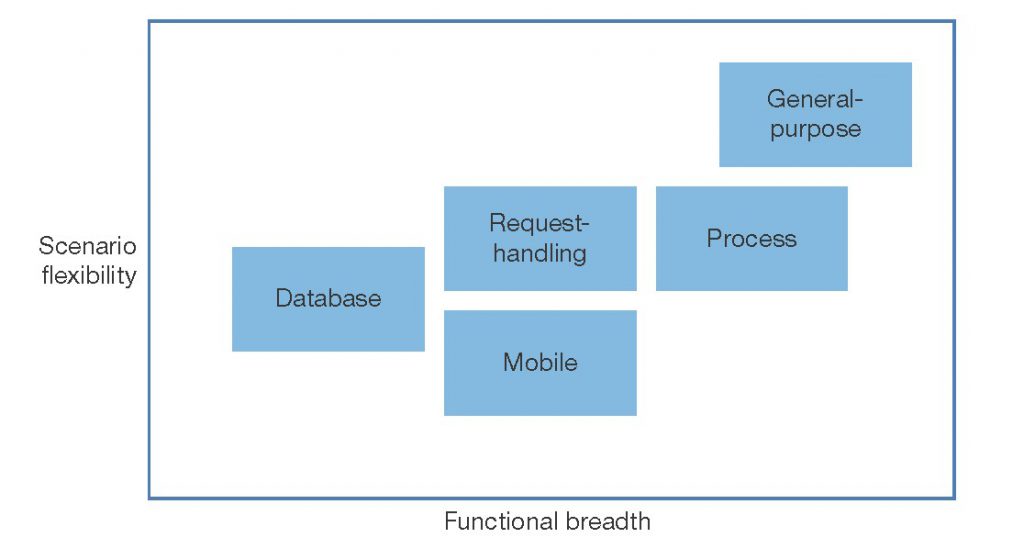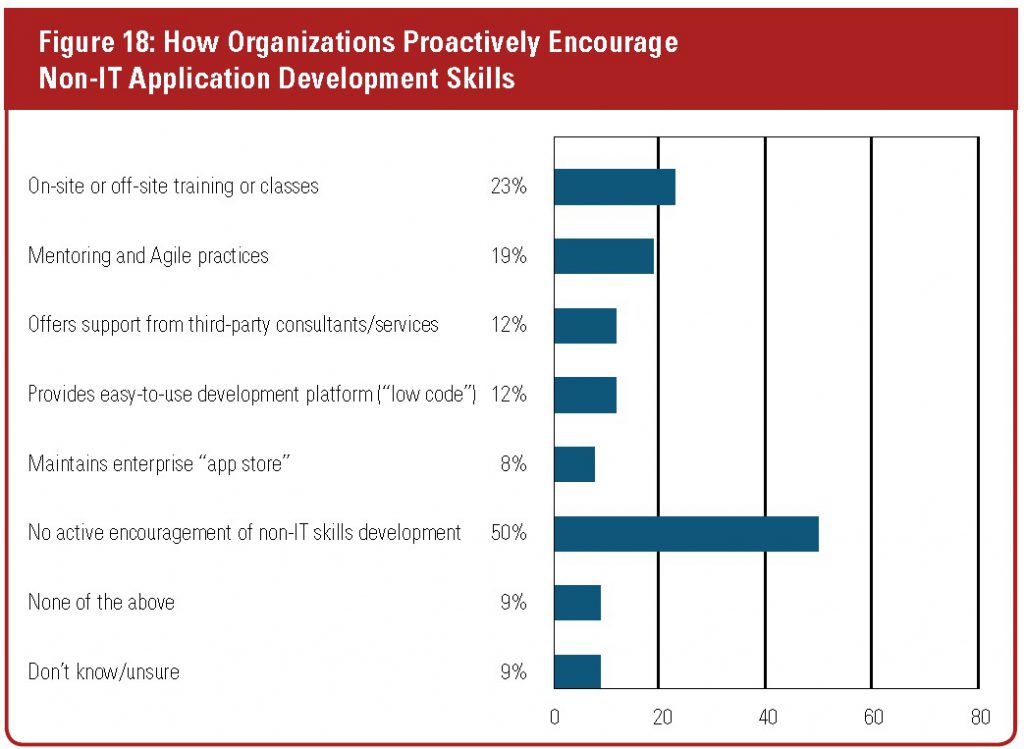Webinar was broadcasted 30th of May 2019. Accessed 18th of October 2019 via https://www.brighttalk.com/webcast/17238/360605/transform-the-customer-experience-without-limits-with-low-code.
Speakers:
Charles Araujo, Principal Analyst – Intellyx – Analyst and advisor in digital transformation
Mike Thompson, VP of Product Marketing – Kony – supplier of low code platforms
What is the main driver of the low-code platform application?
The main driver for the current low code movement, is the quickly needed development of IT solutions. The IT resources are scares as they have been for decades and companies are looking for possibilities to do more with the available resources. In the last 10 years the technology development towards low-code platforms creates the ability to have a simple and flexible interface for non-IT users that includes governance.
Where are we going?

All challenges generated by the immense increase of the customer demand must be tackled. This triggered further need for agility and flexibility. However, digital transformation has less to do with technology and is more about business model transformation and the customer experience, which is now the ultimate business driver of value. Low-code platforms are the ‘engine’ of the customer experience by putting development in the hands of the people where the customer experience is happening.
Three level approach
There is narrow view; applying low-code for optimization of current processes and creating efficiency. The second level is using low-code platforms to support the transformation of the customer experience. The third level has to do with the possible results for organisational change and mitigation of political issues. It can bring together employees from different divisions and departments, because they are working with the same tool on the same challenges; improving the customer experience.
Quality of the webinar
The facilitator is not making clear what the target audience is. The speakers are not located in the same room and interact remotely. The plus is that they do not use PowerPoint slides, but are presenting themselves and talk about their experience and question each other. The minus is that the interaction between them can be perceived as ‘distanced’ and not connected.
Charles Araujo is an experienced analyst at Intellyx and has published a book and is keynote speaker on digital transformation. Mike Thompson is VP at Kony (low-code platform vendor) and has a rich background in marketing and product development. Both can be seen as valid speakers on this topic.
The quality of the webinar improves when Charles Araujo is questioning Mike Thompson on what is really better when he talks about the limitless possibilities of Kony. On this question he is repeating possibilities of the Kony low-code platform. It would have been stronger if he had included examples of differences with other platforms on speed, value and flexibility underpinned with market research.
Mike Thompson from Kony share three client cases. When discussing these cases it is not clear what Kony’s approach was to support the clients and how they managed the projects.
At the end questions can be asked but the answers are not bringing new information. Contact information and further resources at Kony are presented at the end of the webinar. The title of the webinar represents the content.
Review
They start with a definition of a citizen developer: a citizen developer is someone outside the IT department working on tool development, but assume that attendees already know what a low-code platform is about. It would have been helpful to also outline the difference between low-code and no code platforms.
“Without data you’re just another person with an opinion” (Deming). In the webinar they do not present any data, the participant might perceive their arguments as an opinion. It would have been better when they had included a reflection on independent research from for example Forrester. Forrester presented some case results of low code platform projects (see fig. 1) (Richardson & Rymer, 2016), which in general seem to confirm the 50% cost reduction from one of Kony’s clients.

They also could have elaborated on the findings in the Forrester Wave™ (Rymer & Koplowitz, 2019), which was presented just one month before this webinar. Kony is a ‘leader’ in the Forrester Wave and a specialist in mobile application platforms and excellent in governance, but falls short on process automation.
Low-code vs No-code
Differences between low-code and no-code are not discussed. One of Kony’s competitors Outsystems expresses that no-code solutions are build for citizen developers and applications build with no-code are difficult to customize. Separate from that, low-code applications should be used by enterprise developers for mission critical processes and are more flexible for customization than no-code platforms (www.outsystems.com, 2019). According to BMC it is likely that organisations need to use both low-code and no-code (www.bmc.com, 2019). This is in contrast with the webinar in which they do not separate between low- and no-code and the distinguished role of the citizen developer which is only appropriate for no-code platforms.
Vendor landscape is fragmented
It is important to understand that the low-code vendor landscape is fragmented where different vendors are delivering different combinations of the segments as presented by Forrester (Richardson & Rymer, 2016) in figure 2.

One of the potential risks from this situation is that customers with little awareness about low-code have difficulty to find the best partner to fit to their goals (Richardson & Rymer, 2016). Adding information about the Kony portfolio would have supported a better understanding of their arguments.
There is little research available on how companies are working with citizen developers. The results (see fig. 3) from a Kintone research (Lundov & Logis, 2017) show that over 50% have no active support for the citizen developer in place.

Although CIOs confirm that low-code can fill the IT skills gap, they recognize the resistance at the IT department which might cause the little support for the citizen developer (Suer, 2019).
Conclusions & recommendations
Digital transformation is in fact business model transformation which focuses on the transition of the customer experience. To really meet the needs within the customer journey, quick and anticipated solutions are necessary. Low-code software can expand the IT resources with introducing the citizen developer. More important, the citizen developer is working where the customer experience is happening and, in that situation, best suited to develop tools to meet the customers expectations. For companies starting with low-code a clear strategy and approach is recommended, because there are a lot of different solutions available suitable for different challenges. It is important to define a clear strategy on combining low-code and no-code platforms. Be aware of possible differences between those two and which one will fit your citizen developers the best.
Further research
The citizen developer movement could just be an additional trigger for organisational changes needed to support the competitive advantage challenges. Low-code and no-code platforms support and require the cooperation of IT and the business in itself. With the citizen developer the business automatically is involved. The challenge to have limited application developed for the same company wide customer journeys, forces people from various divisions and departments to connect and work together in cross functional teams. The citizen development movement might just be an addition means to support serendipity. Further research is recommended to understand the current adoption of citizen developers and its possible support for the organisational transformation towards customer journey driven value chains.
Reference list
Araujo, C., Thompson, M. (2019). Webinar: ‘Transform the Customer Experience without Limits (with Low-Code)’. https://www.brighttalk.com/webcast/17238/360605/transform-the-customer-experience-without-limits-with-low-code. Accessed on 17th of October 2019.
BMC. Watts, S. (2018). Low Code vs No Code: Is it the future of Coding in the Enterprise? https://www.bmc.com/blogs/low-code-vs-no-code/. Accessed 17th of October 2019.
Lundov, S., & Tarp Logis, S. (2017). The Rise of the Empowered Customer. 2017 LOW-CODE ADOPTION SURVEY (November), 1–135. Kintone. www.dtba.com. Access 17th of October 2019.
Outsystems. Souther, S. (2019). Low-code vs No-code: What’s the real difference. https://www.outsystems.com/blog/posts/low-code-vs-no-code/. Accessed on 17th of October 2019.
Richardson, C., & Rymer, J. R. (2016). Vendor Landscape: The Fractured, Fertile Terrain Of Low-Code Application Platforms The Landscape Reflects A Market In Its Formative Years. www.forrester.com accessed 17th of October 2019.
Rymer, J. R., & Koplowitz, R. (2019). The Forrester WaveTM: Low-Code Development Platforms For AD&D Professionals, Q1 2019. Forrester. Retrieved from https://reprints.forrester.com/#/assets/2/108/RES144387/reports. Accessed 6th of October 2019.
Suer, M.F. (2019). What CIOs need to know about low code software development. https://www.cio.com/article/3410878/what-cios-need-to-know-about-low-code-software-development.html. Accessed 17th of October 2019.


Recent Comments